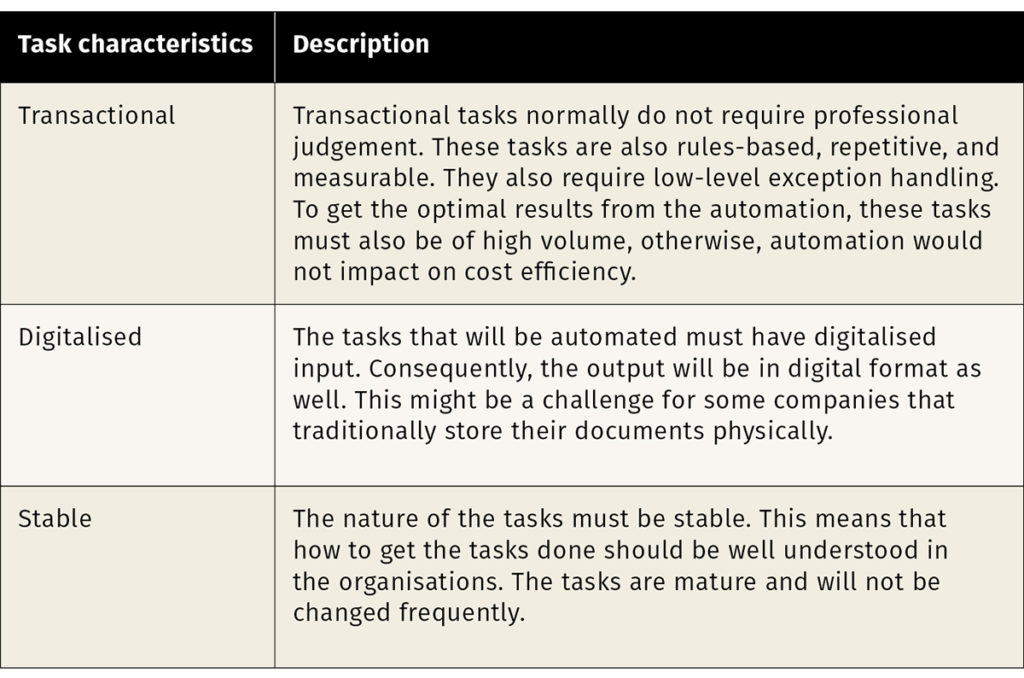Intelligent Automation

By Arif Perdana and Kevin Ow Yong
BUSINESS PROCESS MANAGEMENT AND TECHNOLOGY
Enterprises, in their endeavours to accelerate digital transformation, have been increasingly adopting smart automation technologies to enhance business performance and process efficiency, and also to reduce costs. Automation is gaining momentum to help industries accelerate digital transformation. Within a short span of time, automation has shifted from a native approach to multiplatform. One key challenge to the native approach is that different software may not be able to interact with each other. For example, a company’s enterprise software output may not be able to seamlessly link to its tax application. To solve this issue, companies may use an application programming interface (API) to connect the different software. However, its implementation is optimal if it involves only two applications. If multiple software need to be connected to generate the intended output, then robotic process automation (RPA) is more effective than an API.
RPA WITH INTELLIGENT AUTOMATION
RPA can be used to automate and optimise several business processes. It can help save time, effort and money while producing quick, accurate and consistent results. The advantage of using RPA is the ease of deployment compared to developing dedicated automation tools from scratch. It also requires fewer programming skills, so the finance professionals can be involved in RPA and simultaneously keep themselves in the control loop of automation. RPA can also work with companies’ legacy systems as it links these systems to the new enterprise systems, analytics software, and office application suites. Other than connecting different software, RPA is also evolving into intelligent automation (IA) as its capability is enhanced by the Internet of Things, artificial intelligence (AI), and machine learning. It helps to automate repetitive and mundane tasks, and also helps facilitate pattern identification, document understanding, and predictive modelling. While traditional RPA is procedural in nature, IA combines both procedural and data-driven processing. This means that when IA works with data, the more data that are supplied to the IA, the smarter the IA is in generating the intended output.
While IA is likely to benefit organisations, it is not a panacea that can cure every business problem. As the late Bill Gates once said, “Automation applied to an inefficient operation will magnify the inefficiency.” Prior to the IA implementation, firms need to ensure that their business processes are well organised and properly documented. Automation implementation is, therefore, not only about the sophistication of automation technology but also its managerial processes. Understanding and awareness of the business processes is critical in IA implementation. Organisations can use the business process management (BPM) cycle to help them comprehend their business processes and make their business processes more efficient.
BUSINESS PROCESS MANAGEMENT CYCLE
The BPM lifecycle includes process identification, process discovery, process analysis, process redesign, process implementation, and process monitoring (Figure 1).
Figure 1 Business process management cycle

a) Process identification
In process identification, organisations must identify how the processes are done and how they are linked to other processes. At this stage, organisations must also evaluate whether the processes have achieved the intended goals (for example, operational efficiency, economic benefits, and customer satisfaction). All these goals must be measurable.
b) Process discovery
This is needed to document the business process scenarios and help identify both unnecessary and essential details.
c) Process analysis
Process analysis identifies the existing processes to determine whether or not they are inefficient or complex. Routine and mundane tasks should be addressed by automation technology.
d) Process redesign
The logic and workflow of the processes must be streamlined through process redesign before automation kicks in to facilitate the automation implementation. The processes also need to be extracted into identifiable tasks. Subsequently, firms must evaluate which tasks they need to automate because not all tasks will benefit from automation. Table 1 recommends three essential task characteristics that are relevant for automation.
Table 1 Relevant tasks to be automated

e) Process implementation
After identifying the relevant tasks to be automated, organisations need to appoint automation champions and establish the appropriate policies for process implementation. Automation champions ensure that automation solutions are properly planned, developed and implemented. They also need to promote IA use to the entire organisation. Additionally, automation policy is critical to guide organisations to undergo proper change management during the implementation. Strong automation champions are required to support the IA system in the long term. While IA reduces numerous manual tasks, IA cannot substitute the full workforce by taking over all the tasks. Automation champions must be aware of the strengths and limitations of the automation solutions.
Automation champions provide recommendations to senior management regarding the feasibility of automation implementation, for example, by considering the firm’s size, nature, financial and human resources. Automation is costly, particularly for small businesses; costs may involve development and maintenance costs. Automation champions, therefore, must cautiously estimate the economic benefits resulting from automation implementation.
In addition to being responsible for designing the solutions, automation champions also need to educate employees and enhance their understanding of automation solutions before and after the solutions’ development and deployment. Regardless of an enterprise-wide or business processes IA implementation, employees may perceive automation as a threat as they fear that automation may disrupt their work or worse, take over their jobs.
To alleviate this concern, automation champions should strategically align the learning and development function, and establish an enterprise-wide IA governance framework. The champions should also understand employees’ behaviour, for example, how they will react to the transformation. This strategic alignment requires constant communication between senior management and its workforce to create a strong organisational culture that supports a successful automation implementation. Implementation of IA across the entire organisation can only be successful with close cooperation within and between departments. Each department needs to work very closely with the automation champions, regularly communicating their needs, and providing suggestions and recommendations to maximise the benefits of IA.
In today’s ever-evolving world, change is a necessity. However, many companies are hesitant to make that leap to implement IA. As IA is relatively new to most employees, there is a need to get employees to understand that there will be a massive shift in the skills that will be needed at the workplace. This shift in skills can be presented as an excellent opportunity for them to upskill themselves, instead of a challenge or a threat. The company can then start developing employees with the new and appropriate skills for the job.
f) Process monitoring
Once the automation solutions have been implemented, automation champions must monitor whether the solutions help their organisations achieve the intended goals formulated in the process identification. This process monitoring evaluates the output of automation based on the available metrics, such as whether or not the automation can speed up the processes. The metric that is relevant for this evaluation is the percentage of lead time before and after automation. If automation is intended to achieve economic benefits, automation champions must justify the percentage of sales increase or the quantum of operational cost decline due to the automation solutions.
Another possible outcome assessment is how much automation has improved customer satisfaction. Has it, for example, reduced the number of errors/faults made when serving the customers? Or has automation decreased the percentage of complaints from total customer feedback? The relevant metrics can be obtained via a customer satisfaction survey. Automation champions need to re-evaluate the business processes and automation technology if the automation solutions did not provide favourable outcomes during the monitoring process.
CONCLUSION
Instilling a technology mindset among employees in an organisation is not an easy feat. Moreover, installing technological solutions takes time and effort, costs money, and also requires senior management approval to support the initiatives.
As part of the Singapore government’s initiative to provide support in this area, the Accountancy Industry Digital Plan (IDP) was launched to digitally transform the accountancy sector. The Accountancy IDP was developed by Singapore Accountancy Commission (SAC), Institute of Singapore Chartered Accountants (ISCA) and Infocomm Media Development Authority (IMDA). It is part of IMDA’s SMEs Go Digital Programmeto help small and medium-sized practices (SMPs) embark on their digital transformation journey.
The SMP Centre and Accounting Technology & Innovation Centre (AccTech Centre) work closely together and with SMPs in their digital initiatives. The SMP Centre is a dedicated, one-stop repository of information, tools and services designed to help SMPs build productive and competitive businesses. The AccTech Centre, a joint initiative between Singapore Institute of Technology (SIT) and SAC, serves as a resource centre to facilitate collaboration, catalysing technology and business innovation in the accountancy sector. Through AccTech Centre, SMPs will have the opportunity to work with SIT faculty, technology partners, and government agencies to innovate processes, service delivery, products and business models in implementing feasible technological solutions that involve RPA, data analytics and AI initiatives.
Arif Perdana is Assistant Professor, Singapore Institute of Technology (SIT), and Kevin Ow Yong is Associate Professor, SIT, and Head, Accounting Technology & Innovation Centre.
This article was first published by ISCA Journal. You can visit the original page here.












